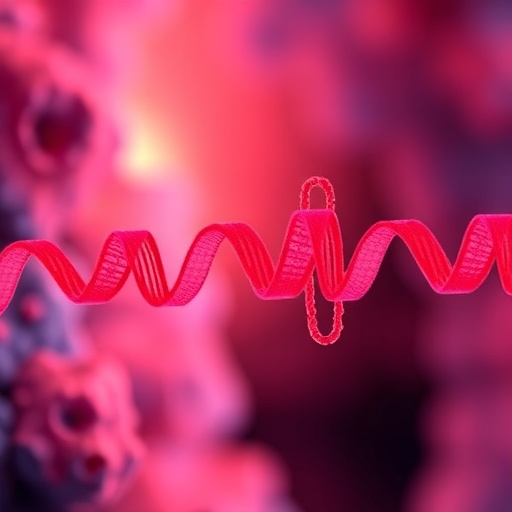A groundbreaking clinical trial conducted at UMass Chan Medical School has demonstrated promising biochemical correction in patients afflicted with GM2 gangliosidosis, a devastating group of neurodegenerative disorders that includes Tay-Sachs and Sandhoff diseases. This Phase I/II study, exploring a pioneering dual vector gene therapy approach, heralds a significant step forward in the quest for effective treatments for these currently incurable conditions. Importantly, the therapy elicited minimal adverse effects, underscoring its safety and potential for transformative patient outcomes.
Led by Heather Gray-Edwards, DVM, PhD, assistant professor of genetic and cellular medicine at UMass Chan, the study assessed the ability of viral vectors to deliver functional copies of the defective genes responsible for GM2 gangliosidosis directly to the central nervous system. The dual vector system employed two recombinant adeno-associated viral vectors (rAAVrh8) injected into the thalamus and spinal cord, areas critical for neurological function. Once administered, these vectors deliver DNA instructions that enable brain cells to produce beta-hexosaminidase A (HexA), an enzyme absent or deficient in patients, which is essential for preventing the buildup of harmful GM2 gangliosides.
The clinical trial enrolled nine participants across four escalating dose cohorts, meticulously evaluating the safety and efficacy of the gene therapy. While therapeutic enzyme levels were not fully achieved, all participants demonstrated increased HexA activity, with enzyme levels doubling the lower threshold of normal. Notably, the vectors’ transgene expression proved functional, a critical milestone confirming that the delivered genetic material translated effectively into enzyme production within neuronal cells, as verified by longitudinal biochemical assays.
.adsslot_6DWrpe4EJY{width:728px !important;height:90px !important;}
@media(max-width:1199px){ .adsslot_6DWrpe4EJY{width:468px !important;height:60px !important;}
}
@media(max-width:767px){ .adsslot_6DWrpe4EJY{width:320px !important;height:50px !important;}
}
ADVERTISEMENT
Clinically, the therapy yielded encouraging benefits. Participants maintained oral feeding capabilities significantly longer than historic benchmarks, with half of the cohorts sustaining full oral intake for more than 25 months. This contrasts sharply with traditional disease progression, where most children with GM2 gangliosidosis require intravenous feeding by 13 to 18 months of age. Moreover, seizure onset was delayed and seizures themselves were reduced in severity and frequency, responding more effectively to anticonvulsant medications, thereby substantially improving quality of life metrics in affected children and their families.
GM2 gangliosidosis disorders stem from mutations primarily in the HEXA or GM2A genes, disrupting the production or function of HexA enzyme and leading to fatal accumulation of GM2 gangliosides in neuronal tissues. The resultant neurodegeneration typically manifests in infancy, presenting as developmental regression, hypotonia, seizures, and motor dysfunctions, rapidly progressing to death within the first few years of life in most cases. Tracing this pathophysiology intricately, the trial’s approach directly addresses the enzymatic deficit at the molecular level, promising a mechanistic intervention to halt or slow disease progression.
The dual vector strategy capitalizes on the unique biology of AAV vectors, which are known for their neuronal tropism, low immunogenicity, and ability to confer long-term gene expression without genomic integration. By targeting the thalamus and spinal cord, the researchers maximized distribution of therapeutic gene payloads to widespread neuronal populations implicated in disease pathology. The vectors’ DNA cargo remains episomal inside nuclei, enabling sustained HexA enzyme production without the risks associated with integrating viral vectors, such as insertional mutagenesis, a key safety advantage in clinical translation.
Despite these advances, limitations remain. The partial biochemical effects and sub-therapeutic enzyme levels highlight the need for further optimization. Moving forward, the research team intends to engineer a single viral vector carrying the full therapeutic payload, doubling the DNA dose per cell without increasing injection volume. This refinement is poised to enhance gene delivery efficiency and therapeutic potency, addressing a principal bottleneck in scaling the treatment to enable earlier and more effective intervention, potentially prior to symptom onset.
Supporting this innovation, the trial was underpinned by interdisciplinary collaboration, including independent clinical assessments from Massachusetts General Hospital and foundational gene therapy vector development co-led by Miguel Sena-Esteves, PhD, associate professor of neurology. Their combined expertise has been critical in refining vector design, delivery protocols, and clinical evaluation metrics, reinforcing UMass Chan’s leadership in translational molecular therapeutics encompassing rare genetic neurological disorders.
The broader implications of this research extend beyond GM2 gangliosidosis. Successful modulation of central nervous system enzyme deficiencies through targeted viral vector gene therapy opens pathways for treating a spectrum of lysosomal storage diseases and other inherited neurodegenerative conditions. The precise delivery techniques and safety profiling established herein provide a replicable framework for next-generation gene therapies, potentially revolutionizing management and prognosis across multiple devastating pediatric disorders.
Funding for the study was provided through dedicated foundations committed to rare disease research, including the National Tay-Sachs & Allied Diseases Association, Cure Tay-Sachs Foundation, Matthew Forbes Romer Foundation, and Blu Genes Foundation. Their support was instrumental in bridging the translational gap from bench to bedside, enabling complex clinical trial design and execution within specialized tertiary care environments.
UMass Chan Medical School, as part of the University of Massachusetts system, continues to drive innovation at the interface of genetic engineering, clinical medicine, and biomedical research. With robust support from philanthropic investments and a seasoned research infrastructure, including its renowned T.H. Chan School of Medicine and MassBiologics division – the only nonprofit FDA-licensed manufacturer of biologics and gene therapy vectors in the U.S. – the institution remains poised to shepherd emerging molecular therapies toward clinical fruition.
In summary, this Phase I/II trial represents a pivotal leap in treating GM2 gangliosidosis by biochemically restoring enzymatic function with a shrewdly engineered gene therapy approach. While challenges endure, the encouraging clinical and biochemical outcomes foster essential optimism for future iterations of the therapy. As research advances toward single-vector constructs and earlier intervention timelines, the prospect of transforming the lethal trajectory of Tay-Sachs, Sandhoff, and related disorders inches closer toward reality, offering renewed hope to affected families worldwide.
Subject of Research: People
Article Title: Dual-vector rAAVrh8 gene therapy for GM2 gangliosidosis: a phase 1/2 trial
Web References:
– Research article: https://www.nature.com/articles/s41591-025-03822-4
– UMass Chan Medical School: http://www.umassmed.edu/
References:
DOI: 10.1038/s41591-025-03822-4
Image Credits: Photo: Bryan Goodchild
Keywords: Gene delivery, Genetic disorders, Medical genetics, Medical treatments, Genetics
Tags: beta-hexosaminidase A enzyme replacementdual vector gene therapy approachGene therapy for GM2 gangliosidosisneurodegenerative disease advancementsneurological disorders gene therapyPhase I/II clinical trial outcomesrecombinant adeno-associated viral vectorssafety of gene therapy treatmentsSandhoff disease researchTay-Sachs disease treatmenttransformative patient outcomes in gene therapyUMass Chan Medical School study





